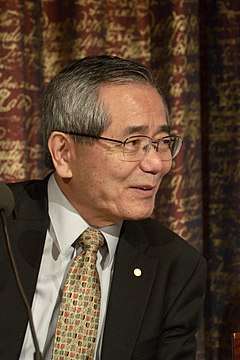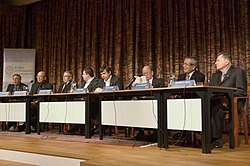Ei-ichi Negishi
| Ei-ichi Negishi | |
|---|---|
 Negishi in 2010 | |
| Native name | 根岸英一 |
| Born |
July 14, 1935 Shinkyō, Manchukuo (now Changchun, China) |
| Residence | United States |
| Nationality | Japanese |
| Citizenship | Japan[1] |
| Alma mater |
University of Tokyo University of Pennsylvania |
| Known for | Negishi coupling |
| Spouse(s) | Sumire Suzuki (m. 1959; d. 2018) |
| Children | 2 |
| Awards |
Sir Edward Frankland Prize Lectureship (2000) Nobel Prize in Chemistry (2010) Person of Cultural Merit (2010) Order of Culture (2010) |
| Scientific career | |
| Fields | Chemistry |
| Institutions |
Teijin Purdue University Syracuse University Hokkaido University |
| Doctoral advisor | Allan R. Day |
| Influences | Herbert Charles Brown |
Ei-ichi Negishi (根岸 英一 Negishi Eiichi) is a Manchurian-born Japanese chemist who has spent most of his career at Purdue University in the United States. He is the Herbert C. Brown Distinguished Professor and Director of the Negishi-Brown Institute at Purdue.[2] He is best known for his discovery of the Negishi coupling.[3] He was awarded the 2010 Nobel Prize in Chemistry "for palladium catalyzed cross couplings in organic synthesis" jointly with Richard F. Heck and Akira Suzuki.[4]
Early life and education
Negishi was born in Hsinking, the capital of Manchukuo (now Changchun, China) 1935,[5] following the transfer of his father who worked at the South Manchuria Railway in 1936, he moved to Harbin, and lived eight years there.[6] In 1943, when he was nine, the Negishi family moved to Incheon, and a year later to Kyongsong Prefecture (now Seoul), both in Japanese-occupied Korea. In November 1945, three months after World War II ended, they moved to Japan. Negishi graduated from the University of Tokyo in 1958 and did his internship at Teijin. He went on to study in the United States and obtained his PhD from the University of Pennsylvania in 1963, under the supervision of professor Allan R. Day.
Career

After obtaining his PhD, Negishi decided to become an academic researcher.[7] Although he was hoping to work at a Japanese university, he could not find a position.[8] In 1966 he resigned from Teijin, and became a postdoctoral associate at Purdue University, working under future Nobel laureate Herbert C. Brown. From 1968-1972 he was an instructor at Purdue.[9]
In 1972, he became an assistant professor at Syracuse University, where he was promoted to associate professor in 1979, before returning to Purdue University as a full professor in the same year.[9]
He discovered Negishi coupling, a process which condenses organic zinc compounds and organic halides under a palladium or nickel catalyst to obtain a C-C bonded product. For this achievement, he was awarded the Nobel Prize in Chemistry in 2010.[10] Negishi has also reported that organoaluminum compounds and organic zirconium compounds can be used for cross-coupling. He has not obtained a patent for this coupling technology, his reasoning being as follows: "If we did not obtain a patent, we thought that everyone could use our results easily."[11] In addition, Zr(C5H5)2 obtained by reducing zirconocene dichloride is also called Negishi reagent and is used for the synthesis of polysubstituted benzene.
Recognition

In 2011, he was awarded an honorary doctor of science degree from the University of Pennsylvania.[12]
Awards
- 1996 – A. R. Day Award (ACS Philadelphia Section award)
- 1997 – Chemical Society of Japan Award
- 1998 – Herbert N. McCoy Award
- 1998 – American Chemical Society Award for Organometallic Chemistry
- 1998-2000 – Alexander von Humboldt Senior Researcher Award
- 2003 – Sigma Xi Award, Purdue University
- 2007 – Yamada-Koga Prize
- 2007 – Gold Medal of Charles University, Prague, Czech Republic
- 2010 – Nobel Prize in Chemistry
- 2010 – ACS Award for Creative Work in Synthetic Organic Chemistry
- 2015 – Fray International Sustainability Award, SIPS 2015[13]
Honors
- 1960-61 – Fulbright-Smith-Mund Fellowship
- 1962-63 – Harrison Fellowship at University of Pennsylvania
- 1987 – Guggenheim Fellowship, 1987
- 2000 – Sir Edward Frankland Prize Lectureship[14]
- 2009 – Invited Lectureship, 4th Mitsui International Catalysis Symposium (MICS-4), Kisarazu, Japan
- 2010 – Order of Culture
- 2010 – Person of Cultural Merit
- 2011 – Sagamore of the Wabash
- 2011 – Order of the Griffin
- 2011 – Fellow, American Academy of Arts & Sciences
- 2012 – Honorary Fellowships of Royal Society of Chemistry (RSC)[15]
- 2014 – Foreign Associate of the National Academy of Sciences
See also
References
- ↑ https://www.nobelprize.org/nobel_prizes/chemistry/laureates/2010/press.html
- ↑ "Ei-ichi Negishi". Department of Chemistry Faculty Directory. Purdue University. Retrieved 26 March 2018.
- ↑ Anthony O. King, Nobuhisa Okukado and Ei-ichi Negishi (1977). "Highly general stereo-, regio-, and chemo-selective synthesis of terminal and internal conjugated enynes by the Pd-catalysed reaction of alkynylzinc reagents with alkenyl halides". Journal of the Chemical Society, Chemical Communications (19): 683. doi:10.1039/C39770000683.
- ↑ Press release, Great art in a test tube, Royal Swedish Academy of Sciences. Accessed 6 October 2010.
- ↑ "ノーベル化学賞に鈴木、根岸氏". 琉球新報. 2010-10-06. Archived from the original on 2010-11-30. Retrieved 2010-10-06.
- ↑ "(私の履歴書)根岸英一(2) 1年早く就学 8歳まで満州で生活 遊びに熱中、冬はスケート". 日本経済新聞. 日本経済新聞社. 2012-10-02. Retrieved 2015-08-30.
- ↑ (私の履歴書)根岸英一(10) 帝人に復帰 大学で「優」連発、自信に 新製品阻まれ学会へ転進、日本経済新聞、2012年10月10日
- ↑ ノーベル化学賞:根岸さんうっすら涙「来るものが来た」、毎日新聞(電子版)、2010年10月7日
- 1 2 Editors of Encyclopaedia Britannica (April 24, 2017). "Negishi Ei-ichi". Encyclopædia Britannica. Retrieved 15 March 2018.
- ↑ "ノーベル化学賞に鈴木名誉教授と根岸氏". Sankei Shimbun. 2010-10-06. Archived from the original on 2010-10-06. Retrieved 2010-10-06.
- ↑ "根岸・鈴木氏、特許取得せず…栄誉の道開く一因". Yomiuri Shimbun. 2010-10-07. Archived from the original on 2010-10-09. Retrieved 2010-10-08.
- ↑ Penn's 2011 Honorary Degree Recipients
- ↑ "Prof. Negishi is awarded the Fray International Sustainability Award in Turkey". www.flogen.org. FLOGEN Star OUTREACH.
- ↑ "Professor Ei-ichi Negishi". J. Chem. Soc., Perkin Trans. 1. Royal Society of Chemistry (9): 9–xii. 2001. doi:10.1039/b009326m.
- ↑ Japanese Nobel Prize Chemists Honored by Royal Society of Chemistry | Asian Scientist Magazine | Science, Technology and Medicine News Updates From Asia
External links

- Ei-ichi Negishi - - Purdue University
